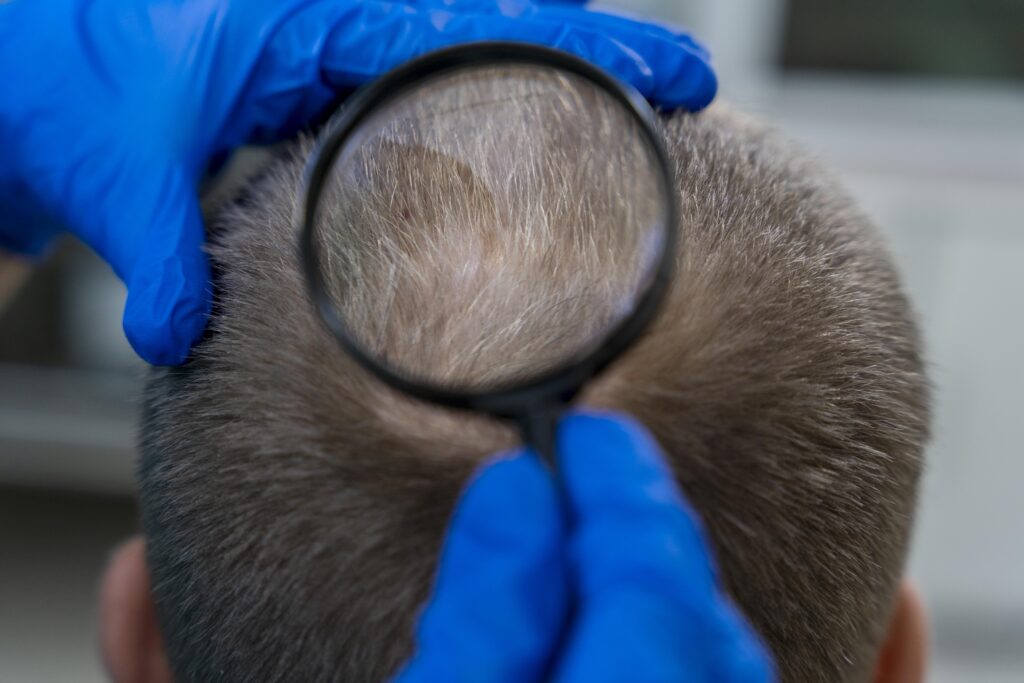Noticing unusual hair loss and wondering how is alopecia diagnosed? Understanding the diagnostic process is crucial for finding the right treatment.
How is alopecia diagnosed typically involves a physical scalp exam, medical history review, and tests like blood work or scalp biopsy.

These steps help identify the type and cause of hair loss—whether autoimmune, hormonal, or stress-related—so you can start effective, personalized treatment.
With insights from board-certified dermatologists, this guide empowers you to take informed steps toward hair recovery and long-term scalp health.
How Is Alopecia Diagnosed?
Alopecia refers to any type of hair loss, but it’s often used to describe autoimmune-related hair disorders such as:
- Alopecia areata (patchy scalp or beard loss)
- Alopecia totalis (complete scalp hair loss)
- Alopecia universalis (loss of all body hair)
- Androgenetic alopecia (male or female pattern baldness)
- Telogen effluvium (shedding after stress or illness)
Each form requires a different diagnostic and treatment approach—making early and accurate assessment essential.
How Do Doctors Diagnose Alopecia?
Hair loss can stem from various causes: genetic, autoimmune, hormonal, nutritional, or environmental. Here’s how a qualified hair specialist like Dr. Rana Irfan assesses alopecia:
🧑⚕️ 1. Medical History and Symptom Discussion
The first step involves a detailed consultation to review:
- When the hair loss began
- Pattern of hair fall (patchy, diffuse, frontal)
- Any recent stress, illness, medication, or diet changes
- Family history of baldness or autoimmune disease
This step narrows down the possible causes and guides the diagnostic direction.
🔬 2. Scalp Examination and Dermoscopy
Using a dermatoscope, Dr. Rana Irfan closely examines the scalp, hair shafts, and follicular openings. This non-invasive technique helps identify features like:
- Exclamation mark hairs (common in alopecia areata)
- Miniaturized hairs (seen in androgenetic alopecia)
- Broken or black dots (indicating inflammation or fungal infection)
🧪 3. Blood Tests
To rule out internal causes, certain blood tests for hair loss may be recommended:
- Thyroid profile (TSH, T3, T4)
- Iron levels and ferritin
- Vitamin D and B12
- ANA (for autoimmune screening)
- Hormone levels (DHT, testosterone in men/women)
🧴 4. Pull Test and Tug Test
This physical test checks how easily hairs are shed when gently pulled. It helps detect active shedding or telogen effluvium.
🧫 5. Scalp Biopsy (if needed)
In rare cases where the diagnosis is unclear, a scalp biopsy may be performed under local anesthesia to examine hair follicles at the microscopic level.

How Do You Know If You Are Getting Alopecia?
Watch out for these early signs of alopecia:
- Round or oval bald patches on the scalp or beard
- Excessive hair fall in the shower or on the pillow
- Sudden thinning of the hairline or crown
- Loss of eyebrows or eyelashes
- Tingling, redness, or itchiness on the scalp
- Nail changes (pitting or ridges, common in alopecia areata)
What Is the First Spot of Alopecia?
The first visible spot often appears:
- On the scalp (especially back of the head) in alopecia areata
- Around the temples or crown in male pattern baldness
- In the beard area in younger males
The location and shape of the hair loss help determine the type and severity of alopecia.
Can Alopecia Be Stopped?
Yes—in many cases, alopecia can be managed or reversed, especially when diagnosed early.
Treatment Options at Dr. Rana Irfan’s Clinic in Islamabad:
- Platelet-Rich Plasma (PRP) Therapy: Stimulates hair regrowth using your body’s growth factors.
- Medical Treatment: Includes topical minoxidil, finasteride, corticosteroids, or JAK inhibitors.
- Hair Transplant Surgery (FUE): Suitable for permanent pattern baldness, performed by Dr. Rana Irfan using minimally invasive techniques.
- Nutritional and hormonal optimization
- Micropigmentation for cosmetic restoration
Who Should Seek an Alopecia Diagnosis?
- Anyone experiencing sudden, patchy, or unexplained hair loss
- Patients with autoimmune disorders
- Individuals with a family history of early baldness
- People noticing changes in hair texture, density, or growth rate

Why Choose Dr. Rana Irfan in Islamabad?
- ✅ ABHRS Certified (American Board of Hair Restoration Surgery)
- ✅ ISHRS Member (International Society of Hair Restoration Surgery)
- ✅ 20+ years of experience in diagnosing and treating complex hair loss
- ✅ Offers PRP, FUE, scalp micropigmentation, and comprehensive evaluations
- ✅ Conveniently located in Islamabad, serving both local and international patients
Local and International Relevance
Located in F-8 Sector, Islamabad, Dr. Rana Irfan’s clinic attracts patients from:
- Rawalpindi, Lahore, Karachi, and Peshawar
- Middle East (UAE, Saudi Arabia, Qatar)
- UK, USA, and Canada
Medical tourists benefit from ethical practices, detailed consultations, and affordable treatment plans in a medically safe environment.
Links Suggestions:
FAQs About Alopecia Diagnosis
How do dermatologists confirm alopecia?
Through clinical examination, dermoscopy, medical history, and relevant blood tests. In some cases, a scalp biopsy may be needed.
What blood tests are done for alopecia?
Common tests include thyroid profile, iron studies, vitamin D, hormone levels, and autoimmune markers.
Is alopecia permanent?
Not always. Some forms (like alopecia areata or telogen effluvium) may reverse on their own or with treatment. Early intervention improves the outcome.
What is the difference between alopecia and hair thinning?
Hair thinning is often gradual and related to aging or hormonal changes. Alopecia may be more sudden, patchy, or autoimmune in origin.
Can PRP help with alopecia?
Yes. PRP therapy is often effective in cases of androgenetic alopecia and early-stage alopecia areata. Dr. Rana Irfan offers PRP under sterile, professional settings.
